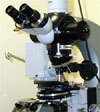Biology
323L
Prof.
R. Malcolm Brown, Jr.
Laboratory
Studies in Cell Biology satisfies Area 1 Blue List
requirements for the cellular or molecular option for the B.A. degree
in biology. This course also satisfies the requirement for an extensive
writing component.
Course Syllabus (in PDF format)
Class Home Page
Instructor
Biographical Sketch (in PDF format)
 |
The
field of cell biology has undergone a revolution since this course was
first offered in 1982. Gene sequencing is now a routine practice,
available to not only molecular biologists but also to cell biologists.
This sequence data is being used to map out the thousands of metabolic
reactions so beautifully compartmentalized within the living
cell. |
| |
|
 |
In fact, cell biology is undergoing a renaissance because it is through
the tools of microscopy and biochemistry that scientists can begin to
fully comprehend the complex metabolic interactions within and between
cells. Because these are such exciting times for cell and molecular
biology, it is my goal to make this class, Laboratory
Methods in Cell Biology, one of the most exciting courses you
will complete in your university program. |
| |
|
|
In BIO 323L/BIO 388L the student will have the unique opportunity to
use high-resolution transmission electron microscopy (HR-TEM) to
visualize the 3.4 Å inter-atomic spacings of carbon atoms in graphite.
The student will have direct access to a state-of-the-art digital image
processing facility where we will demonstrate new applications for cell
and molecular biology. |
 |
| |
|
|
Combining the use of transmission electron microscopy, digital image
processing, video microscopy, and a variety of optical methods, the
student will be exposed to some very sophisticated, recent methods in
cell and molecular biology -- procedures which will most likely be
applied and used during the student's post-graduate and professional
affiliations. The lab exercise on high resolution imaging with the TEM
is a direct outgrowth of former Biology 323L students who inspired me
to seek support from the Welch Foundation on atomic and molecular
imaging with the transmission electron microscope. This year, we will
expand our molecular image vocabulary by taking on new challenges in
the digital processing era. |
 |
As a result of
a substantial grant from the National Science Foundation (IGERT), we
have secured 12 special digital cameras and computers so that images
can be downloaded into the computer and integrated into the lab
reports. This will mark a major improvement for our data recording, and
the student will learn new imaging techniques. We hope to see a major
increase in graduate enrollment under the auspices of IGERT.
Course Objectives:
(1) The student will gain a practical, hands-on experience in cell and
molecular biology rather than reading about it in textbooks. This will
be accomplished through data gathering, observations, and extensive
writing in the form of a laboratory report.
(2) The student should emerge from this course with a better
appreciation for cellular and molecular biology and will be prepared
from this experience to make informed decisions on future career
choices in the biological sciences.
Course Statement:
We encourage the student in Biology 323L/388L to develop an active
participation in this laboratory experience. The class is sufficiently
small that the student will have ample opportunity to get to know the
instructor and teaching assistants, all of whom are dedicated to the
premise that they can be of assistance and provide the learning
experience of a lifetime for the student.
In considering
a given laboratory experiment, the student should try to understand why
a particular experiment was chosen for study, how it may help to better
understand a more general phenomenon, where the laboratory experience
fits into the relevant experimental design and literature on the
particular subject, and who in the field has contributed or is active
in the research area.
We hope that
the student will energetically participate in class discussions and
make suggestions for improving the next round of experiments.
The student
who really enjoys these laboratory exercises and excels in them
frequently demonstrates the motivation and skills to conduct
independent research. Many undergraduate students are not fully aware
of the numerous opportunities to enroll in independent research courses
with UT faculty. Such a favorable combination of circumstances often
leads to a decision to pursue a graduate career in cellular and
molecular biology.
BIO
388L:
BIO 388L is the
graduate version of the undergraduate course BIO 323L. Both classes
meet at the same time and place. Students enrolled in BIO
388L do all of the work done in BIO 323L and in addition undertake a
special project in which they give a 30 minute seminar on an assigned
topic in cell biology. The student presents using PowerPoint and CD-ROM
to gain experience in this new form of communication which is now being
implemented at national and international meetings. The student is
judged on accuracy, style of presentation, clarity, and overall
communication effectiveness. The seminar combines abilities to gather
and organize information on a topic of great interest and to present it
in a relatively short time and make the topic both interesting and
fast-moving!
|


